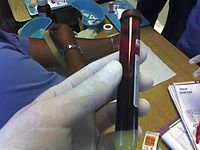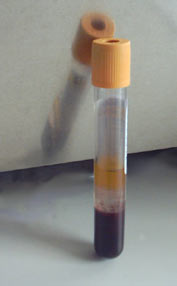
Vacutainer
About this schools Wikipedia selection
SOS Children have produced a selection of wikipedia articles for schools since 2005. SOS Child sponsorship is cool!
Vacutainer is a registered brand of test tube specifically designed for venipuncture. It was developed in 1947 by Joseph Kleiner, and is currently marketed by Becton, Dickinson and company.
Principles
The vein is first punctured with the hypodermic needle, which is connected to a translucent plastic holder. The needle actually has a second, smaller needle, and when a Vacutainer test tube is pushed down into the holder, its rubber cap is pierced. The vacuum in the tube causes blood to move through the needle and into the tube. The tube is then removed and another can be inserted and filled the same way. It is important to remove the tube before withdrawing the needle, as there may still be some suction left, causing pain upon withdrawal.
The test tubes are covered with a colour-coded plastic cap. They often include additives that mix with the blood when collected (see below), and the colour of the tube's plastic cap indicates which additives that tube contains.
The plastic caps are opaque for tubes with a normal vacuum. Translucent-topped tubes contain a weaker vacuum in the same sized tube, and will obtain less blood. The weaker suction makes them more suitable for smaller sized veins. Because of the standardised suction of the tubes, they may cause the veins of elderly people, or those with delicate veins, to collapse. In this case a syringe should be used instead.
Contents of tubes
The tubes may contain additional substances that preserve the blood for processing in the medical laboratory. Using the wrong tube may therefore make the blood sample unusable.
The substances may include anticoagulants ( EDTA, sodium citrate, heparin) or a gel with intermediate density between blood cells and serum. Additionally, some tubes contain substances that preserve certain chemicals or substances within the blood, such as glucose. When the tube is centrifuged, the blood cells sink to the bottom of the tube, are covered by a layer of the gel, and the serum is left on top. The gel enables the tube to be tipped upside-down and transported without the blood cells remixing with the serum. When a tube that does not contain gel or a clotting agent is centrifuged, the clear liquid is plasma, which contains platelets.
The meaning of the different colors are standardized across manufacturers.
The order of draw refers to the sequence in which these tubes should be filled. The needle which pierces the tubes can carry additives from one tube into the next, and so the sequence is standardized so that any cross-contamination of additives will not affect laboratory results .
Containers containing coagulants
- Gold or 'Tiger' Red/Black top: Clot activator and gel for serum separation
- Red top PLASTIC tubes: Contains a clot activator and is used when serum is needed
- Orange or Grey/Yellow 'Tiger' Top: Contain Thrombin, a rapid clot activator, for STAT serum testing
Containers containing anticoagulants
- Green - Contains Sodium Heparin or Lithium Heparin used for plasma determinations
- Light Green or Green/Gray 'Tiger': For plasma determinations in chemistry
- Purple or lavender - contains EDTA (the potassium salt, or K2EDTA). This is a strong anticoagulant and these tubes are usually used for full blood counts (CBC) and blood films. Lavender top tubes are generally used when whole blood is needed for analysis. Can also be used for blood banking
- Grey - These tubes contain fluoride and oxalate. Fluoride prevents enzymes in the blood from working, so a substrate such as glucose will not be gradually used up during storage. Oxalate is an anticoagulant.
- Light blue - Contain a measured amount of citrate. Citrate is a reversible anticoagulant, and these tubes are used for coagulation assays. Because the liquid citrate dilutes the blood, it is important the tube is full so the dilution is properly accounted for.
- Dark Blue - Contains sodium heparin, an anticoagulant. Also can contain EDTA as an additive or have no additive. These tubes are used for trace metal analysis.
- Pink - Similar to purple tubes (both contain EDTA) these are used for blood bank purposes.
Other
- Red (glass)- Contains no additives. Tests for antibodies and drugs often require these.
- Light yellow - Used in HLA phenotyping. Also contains Sodium polyanethol Sulfonate (SPS), which is used for blood culture specimens or acid-citrate-dextrose (ACD), used for blood bank studies, HLA Phenotyping, and paternity testing.
- Tan (glass or plastic): These tan top tubes are used for lead determinations. The tube contains either sodium heparin (glass) or K2EDTA (plastic). These tubes are certified to contain no lead.



